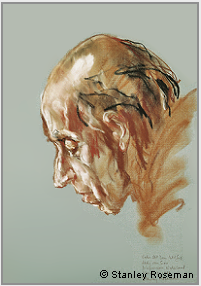
|
Monastic Journey
Continued |
|||||
Stanley Roseman
The MONASTIC LIFE
The MONASTIC LIFE
RETURNING to the NETHERLANDS
Brother Thijs in Prayer, 1984
St. Adelbert Abbey, The Netherlands
Chalks on paper, 50 x 35 cm
Prentenkabinet-Kunsthistorisch Instituut
der Rijksuniversiteit, Leiden
St. Adelbert Abbey, The Netherlands
Chalks on paper, 50 x 35 cm
Prentenkabinet-Kunsthistorisch Instituut
der Rijksuniversiteit, Leiden
St. Adelbert Abbey
5. Brother Ole,
Portrait of a Benedictine Monk
1984, St. Adelbert Abbey,
The Netherlands
Chalks on paper, 50 x 35 cm
Private Collection, Switzerland
Portrait of a Benedictine Monk
1984, St. Adelbert Abbey,
The Netherlands
Chalks on paper, 50 x 35 cm
Private Collection, Switzerland
4. Brother Thijs in the Library
1982, St. Adelbert Abbey,
The Netherlands
Chalks on paper, 50 x 35 cm
Albertina, Vienna
1982, St. Adelbert Abbey,
The Netherlands
Chalks on paper, 50 x 35 cm
Albertina, Vienna
7. Portrait of the Abbot of Sion, 1984, Sion Abbey, The Netherlands
Chalks on paper, 50 x 35 cm
The Israel Museum, Jerusalem
Chalks on paper, 50 x 35 cm
The Israel Museum, Jerusalem
3. Abbot Gerard in Prayer
1997, St. Adelbert Abbey,
The Netherlands
Chalks on paper, 50 x 35 cm
Collection St. Adelbert Abbey
1997, St. Adelbert Abbey,
The Netherlands
Chalks on paper, 50 x 35 cm
Collection St. Adelbert Abbey
2. St. Adelbert Abbey, the Netherlands.
A Sojourn with the Trappist Monks of Sion Abbey
"I am very pleased to let you know that the drawing by Stanley Roseman
has arrived safely and is now in our department.
It is indeed a fine work and a welcome addition to our collection."
has arrived safely and is now in our department.
It is indeed a fine work and a welcome addition to our collection."
- Meira Perry-Lehmann
Curator of Prints and Drawings
The Israel Museum, Jerusalem
Curator of Prints and Drawings
The Israel Museum, Jerusalem
The first year of Roseman's work on the monastic life brought the artist to the Netherlands in October 1978. Over the following years, Roseman returned to the Netherlands with cordial invitations from monasteries that he had not been to before and renewed invitations from monasteries he had come to know well.
"It will be great to see you again in our abbey,'' writes Abbot Gerard Mathijsen, an erudite, tall, gray-bearded man whose gracious hospitality to Roseman and his colleague Ronald Davis was always deeply appreciated.
St. Adelbert Abbey, a Benedictine monastery in the village of Egmond-Binnen near the seacoast in North Holland, traces its history to the tenth century and the patronage of the Counts of Holland. The abbey church, repository of the relics of St. Adelbert, became the court-chapel of the Counts of Holland and the royal burial place for several generations.
By the end of the eleventh century, the Abbey was a flourishing spiritual center with an important scriptorium, where monastic scribes produced, among other notable manuscripts, an early history of Holland.
The years 1934 to 1935 saw the renewal of monastic life at Egmond with the building of a new monastery on the site of the former abbey. Observing a life of prayer, work, and study, the monks of St. Adelbert Abbey also provide a place for interfaith dialogue and foster ecumenism among people of different religions.
Returning to St. Adelbert Abbey
At St. Adelbert Abbey, Roseman drew at the Divine Office, when the monks gathered in choir to pray and chant the Psalms. He drew members of the community in solitary prayer and meditation. Roseman drew monks at work, such as in the kitchen when Brother Cor was preparing meals, and at study in the library, where the artist also did his own study and research in writing a text to accompany his paintings and drawings.
The Abbot writes in January 1994: "Thank you so much for Stanley's splendid card and Ronald's interesting letter." The card that the Abbot refers to reproduces the artist's Alpine Snowscape from his series of landscapes from Switzerland. Davis' letter speaks about living in Paris and Roseman drawing the dance at the Paris Opéra. "It was a great joy to have news from you, especially because it is good news. . . . It will be great to see you again in our abbey. With the best wishes from our community and my affection.''
Abbot Gerard writes in further correspondence, "Be assured of our friendship and our prayers,'' and again renews his invitation: "We hope you are well, and we look forward to seeing you once more at Egmond."
From Roseman and Davis' return to St. Adelbert Abbey in autumn of 1997 is the superb portrait Abbot Gerard in Prayer, (fig. 3).
Abbot Gerard's correspondence over the years with Roseman and Davis is infused with encouragement and enthusiasm, as when the abbot received a gift for the monastery of a fine art print that Davis had published of Roseman's portrait of an English Benedictine monk Dom Henry, in the Musée des Beaux-Arts, Rouen. Abbot Gerard writes in letter of May 1988: "Congratulations with the marvelous reproduction of the portrait 'Dom Henry,' so sincere, warm, impressive. I have displayed the print in the community room, where the brethren can admire this splendid work."
In the gray light of the abbey library, the artist drew the Benedictine monk, seen here in profile, absorbed in his reading. Brother Thijs' ivory complexion is complemented by his dark hair and long beard, which give the monk an appearance consistent with his erudition as a Biblical scholar.
- Brother Thijs Ketelaars, OSB
St. Adelbert Abbey
St. Adelbert Abbey
"It is a pity that I cannot express adequately my feelings in English to say how I have been moved by your text. Father Abbot gave me the text before Compline and so I read it during the night till I had finished because I was caught directly.
"It is a marvellous text. It is not simply an introduction, but a text that is not only scientific, but above all personal and full of deep understanding of the monastic life."
At St. Adelbert Abbey in 1978, Roseman met the librarian Brother Thijs, who befriended the artist, kindly made the library available to him, and assisted him with his research on monastic life.
Having kindly read a draft of the artist's manuscript, Brother Thijs writes in his letter of June 1986:
Portraiture
Portraiture holds an important place in Roseman's oeuvre and accounts for a major part of his work on the monastic life. Aftonbladet, Stockholm, commends Roseman for creating portraits "artistically on a high level as well as accurately expressive of the human dimension.''
''The drawings, done for the most part in combinations of black, white, and sepia chalk
on beige or gray paper, are impressive."
on beige or gray paper, are impressive."
- The Boston Globe
The Benedictine Nuns of St. Lioba Cloister
''This is work that reaches impressive heights,
especially in the portraits of these men and women.''
especially in the portraits of these men and women.''
- NRC Handelsblad, Rotterdam-Amsterdam
Father Jan, who had been a teacher of the Classics for fifteen years in a seminary, was also greatly encouraging to Roseman in his work on the monastic life and read a draft of the artist's manuscript. In letter to Roseman, Father Jan writes:
"Father Gerard asked me to read your text and to make some remarks. After a few pages
it became clear to me this task was a fruitful one: it was 'lectio spiritualis' and literature
at the same time. And an examination of conscience of my own ideal as a monk. . . .
it became clear to me this task was a fruitful one: it was 'lectio spiritualis' and literature
at the same time. And an examination of conscience of my own ideal as a monk. . . .
- Father Jan van Dijk, OSB
St. Adelbert Abbey
St. Adelbert Abbey
© Stanley Roseman and Ronald Davis - All Rights Reserved
Visual imagery and website content may not be reproduced in any form whatsoever.
Visual imagery and website content may not be reproduced in any form whatsoever.
"Just a few words to assure you that Stanley's text arrived. . . .
- Abbot Gerard Mathijsen, OSB
St. Adelbert Abbey
St. Adelbert Abbey
Abbot Gerard kindly read a draft of Roseman's text on monasticism and his work in the monasteries and writes in May 1986 to Davis:
"Your text is a revelation about the monastic history and about your art! My congratulations.''
"Throughout the course of my work and with my love of books," Roseman writes, "I often sought the monastery library in which to draw as well as a place for reading and study.'' In a text to accompany his paintings and drawings, the artist dedicates a chapter to books and libraries not only because his work includes depictions of authors, translators, editors, bookbinders, and librarians but also because of the centuries-old association of monks and books. From the sixth to the twelfth century, monasteries were major producers of books in the West. Scholarship and literary work and the publishing of books continue in monasteries today.
The artist recounts: "Brother Ole, a quiet, introspective man, was the monastery's gardener. He had designed and cultivated a beautiful cloister garden conducive to meditation and private prayer.
Brother Ole, Portrait of a Benedictine Monk, (fig. 5), exemplifies Roseman's painterly use of the medium of chalk. This impressive portrait, in a private collection in Switzerland, is from Roseman's return to St. Adelbert Abbey in the spring of 1984.
In the portrait of Brother Ole, Roseman has rendered the monk's fine facial features with strong contrasts of warm shadows and white highlights complemented by the texture of the monk's black hair and closely cropped beard. The striking mis-en-page places the portrait high on the page, and the gray paper imparts a cool tonality to the flesh tones, especially luminous on the neck, cheek, and temple. With head inclined and eyes lowered, the monk's peaceful continence reveals a life of contemplation and prayer.
The Institute of Art History of the University of Leiden acquired by vote in 1985 of the Institute's young art historians a selection of Roseman's drawings on the monastic life. The Leiden Print Room houses an important collection of master drawings from the Dutch, Flemish, German, French, and Italian schools. The selection of Roseman's drawings includes Brother Thijs in Prayer, 1984, St. Adelbert Abbey. The superb portrait is reproduced at the top of the page and below, (fig. 6).
The acquisition of Roseman's work for the University of Leiden Print Room also includes the equally impressive drawings Sister Maura in Prayer, 1984, a portrait of a Benedictine nun from the Dutch convent of St. Lioba Cloister, (fig. 9, below); as well as Brother Erwin at Vespers, 1982, Benedictine Archabbey of St. Ottilien, Germany; Brother Caesarius at Breakfast, 1982, Lutheran Benedictine Abbey of Östanbäcks, Sweden; and Brother Rufus in Choir, 1984, Trappist Abbey of Mount St. Bernard, England.
Roseman recalls: "In returning to St. Adelbert Abbey that spring of 1984 and greeting Brother Thijs again, it hardly seemed two years had passed as we fell immediately into conversation as though we had been speaking together just a few days before. With renewed enthusiasm for my drawings and my interest in monasticism, Thijs continued to encourage me in writing a contextual background to my work on the monastic life.'' (See the letter quoted above from Brother Thijs regarding the artist's text.)
In the Leiden portrait Brother Thijs in Prayer, bold contours define the monk's head and face, seen in three-quarter profile, and his full beard. Vigorous strokes of black chalk are complemented by the fine modeling of the monk's face with warm shading, cool skin tones suggested by the gray paper, and accents of luminous, white highlights. The monk's eyes are closed and his lips seem to be moving slightly as he prays quietly to himself.
Roseman has created a portrait of intense spirituality. This compelling portrait drawing of Brother Thijs invites the viewer to share in an intimate moment of meditation and prayer.
6. Brother Thijs in Prayer
1984, St. Adelbert Abbey,
The Netherlands
Chalks on paper, 50 x 35 cm
Prentenkabinet-Kunsthistorisch
Instituut der Rijksuniversiteit, Leiden
1984, St. Adelbert Abbey,
The Netherlands
Chalks on paper, 50 x 35 cm
Prentenkabinet-Kunsthistorisch
Instituut der Rijksuniversiteit, Leiden
The Israel Museum, Jerusalem, conserves Roseman's excellent Portrait of the Abbot of Sion, (fig. 7, below), also from the artist's return to the Netherlands in 1984.
When Roseman and Davis were at St. Adelbert Abbey, Abbot Gerard told them that he had spoken enthusiastically about the artist's work on the monastic life to the Abbot of Sion Abbey, a Dutch Trappist monastery founded in 1833 in the eastern province of Overijssel. Abbot Adolfus van der Zeijden kindly extended an invitation to the artist and his colleague, and that spring they drove to the monastery.
9. Sister Maura in Prayer
1984, St. Lioba Cloister,
The Netherlands
Chalks on paper, 50 x 35 cm
Prentenkabinet-Kunsthistorisch
Instituut der Rijksuniversiteit, Leiden
1984, St. Lioba Cloister,
The Netherlands
Chalks on paper, 50 x 35 cm
Prentenkabinet-Kunsthistorisch
Instituut der Rijksuniversiteit, Leiden
8. Sister Maura at Vespers, 1984
St. Lioba Cloister,
The Netherlands
Chalks on paper, 50 x 35 cm
Collection St. Lioba Cloister
St. Lioba Cloister,
The Netherlands
Chalks on paper, 50 x 35 cm
Collection St. Lioba Cloister
Vigorous strokes of white chalk strengthen the textural quality of the Abbot's beard and add brilliant highlights to his cheeks and brow. The blending of black and white chalks and the reserved areas of the gray paper imbue the composition with a silver tonality in this deeply felt portrait of the Benedictine Abbot in prayer.
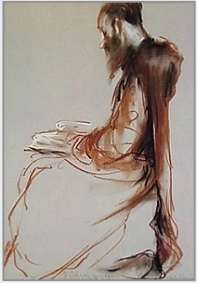
In the Library of St. Adelbert Abbey
Returning to the Abbey in 1982, Roseman drew the present work entitled Brother Thijs in the Library, a beautiful chalk drawing rendered with an harmonious interplay of line and tone, (fig. 4). The Graphische Sammlung Albertina, Vienna, acquired the work for its renowned collection of master drawings. Brother Thijs in the Library was featured on the poster for the Albertina's exhibition Stanley Roseman - Zeichnungen aus Klöstern (Drawings from the Monasteries), 1983, the museum's first one-man exhibition of drawings by an American artist. (See the website page "Stanley Roseman - Exhibition at the Albertina, Vienna.")
Holland Revisited
The Bibliothèque Nationale de France in its biographical essay on Stanley Roseman states: "With a seriousness that pushes him always further in treating a subject or theme, he continually clarifies and refines, never letting his interest waiver or diminish.''
Returning to the Netherlands in 1997, Roseman took up his paper and chalks again at St. Lioba Cloister, where his work includes drawings of Sister Maura and Sister Elisabeth, a pleasant, elderly woman who was a founding member of the Monastery.
A significant aspect of Roseman's oeuvre on the monastic life is the passage of time expressed in returning to a place and the artist's paintings or drawings of an individual over the years.

"Stanley Roseman lived in monasteries of monks and nuns of the four contemplative orders
throughout Europe and created an extensive oeuvre of chalk drawings
profoundly expressive of the individual and the interior life''
throughout Europe and created an extensive oeuvre of chalk drawings
profoundly expressive of the individual and the interior life''
- Bibliothèque Nationale de France
11. Brother Thijs, Portrait of a Benedictine Monk in Prayer
1997, St. Adelbert Abbey,
The Netherlands
Chalks on paper, 50 x 35 cm
Collection St. Adelbert Abbey
1997, St. Adelbert Abbey,
The Netherlands
Chalks on paper, 50 x 35 cm
Collection St. Adelbert Abbey
10. Stanley Roseman drawing Brother Thijs in choir, St. Adelbert Abbey, the Netherlands, 1997.
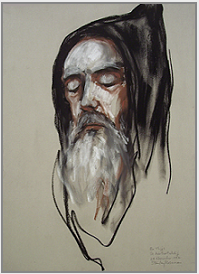
The Benedictine convent of St. Lioba Cloister on the coast of North Holland was founded in 1935. In a variation of the traditional Benedictine nun's habit of black tunic and scapular, the sisters of St. Lioba Cloister wear monastic habits of pearly gray material, belted at the waist, and with hoods rather than wimples and veils or head scarves, customary headdresses for women religious.
"It was a unique experience for me which I will never forget; I close you in my heart. Each and every human performance from the mere everyday work to a work of art, is never just a reflection of reality, but at the same time it is a model and a design of a world that should be new again, so it is a plan of our future.
"Please accept my very best wishes and my affectionate greetings - to Ronald as well. Hoping to see you again some day."
Returning to the Netherlands in 1984, Roseman and Davis were cordially welcomed by the superior of the convent, Sister Karen, and the Community of St. Lioba Cloister.
Roseman's work at the Monastery includes the beautiful drawing Sister Maura at Vespers, reproduced here, (fig. 8), and the superb portrait Sister Maura in Prayer, (fig. 9, below).
Sister Maura, a gracious lady with long dark hair worn in a chignon, was a sensitive, caring person and one of the first women to join the new monastery.
- Sister Maura, OSB
St. Lioba Cloister
St. Lioba Cloister
Sister Maura's commitment to and love for the contemplative life was an inspiration to her Community. When Maura passed away in 2001, the sisters reproduced the drawing Sister Maura at Vespers on her prayer card and thoughtfully noted the artist, who had made a gift of the drawing to the monastery.
Brother Thijs, Portrait of a Benedictine Monk in Prayer, presented here, (fig. 11), is an arresting portrait expressive of the man's deep spirituality.
Roseman's work from St. Adelbert Abbey includes the portrait of Abbot Gerard, (fig. 3, above); drawings of Brother Thijs and Brother Ole; as well as a suite of drawings of Brother Cor praying in the church and cooking in the kitchen. (See "Ora et Labora, Prayer and Work'' - Page 2.)
"A stunning series of drawings depicting the monastic life in Europe."
- The Associated Press, Rome
In the photograph, the artist is seated on a low, portable bench which he carried with him for his work. The artist's large drawing book rests on his knees. Tucked into his work apron is a cloth for wiping the chalk dust off his hands.
Although Sister Maura was not a conventionally pretty woman, she was a beautiful person of great spiritual intensity, as expressed in Roseman's deeply moving portrait Sister Maura in Prayer.
The leading Dutch newspaper NRC Handelsblad published an enthusiastic reportage on Roseman's work on the monastic life and states:
The Curator of Prints and Drawings of the Israel Museum, Meira Perry-Lehmann, writes in her cordial letter of April 1986 acknowledging receipt of the Portrait of the Abbot of Sion:
The biography appears in the publication by the Bibliothèque Nationale de France for its exhibition Stanley Roseman - Dessins sur la Danse à l'Opéra de Paris, 1996. The dance was a subject of the artist's work in New York City in the 1970's and to which he returned through the 1990's with an invitation to draw the dance at the Paris Opéra. A diversity of subjects from the artist's early career in the United States - the performing arts, portraits, nudes, landscapes, still lifes, and animal companions, including his Abyssinian cat named Aby, as well as the work he began in Europe in 1978 on the monastic life - are all subjects to which the artist has returned over the years, "never letting his interest waiver or diminish.'' (See "Biography.")
"Ole and I share an interest in nature: his, expressed through his work in horticulture; mine, in painting and drawing landscapes. We also share an affection for cats, which I came to know having seen Ole feeding a cat in the cloister garden. I mentioned that in my youth I had a feline companion who accompanied me to New York City when I started out on my career. Brother Ole told me he grew up on a farm in Norway and had cared for a feline companion, a stray cat who one day had come around to the farmhouse and was adopted by Ole and his family."
Abbot Adolfus, a gracious, middle-aged man, warmly welcomed Roseman and Davis to Sion Abbey. Greatly encouraging to the artist, the Abbot said to Roseman that his work brings an awareness of contemplative life in the modern age and fosters understanding and ecumenicism between people of the Jewish and Christian faiths.
"I asked the Abbot if I may include a portrait of him in my work on the monastic life. Abbot Adolfus told me that he was also the librarian and kindly invited me to join him at his desk in the library, where he worked and studied as well as where he did his spiritual reading.
"The library at Sion Abbey was a modest-sized room that seemed filled to capacity with books. I was very pleased to be drawing in the library, for with my love of books, I often sought monastery libraries in which to draw as well as for reading and study. I sat near the Abbot, whose desk was placed by a window which brought a clear, morning light into the room and illuminated the face of the ascetic Dutchman absorbed in his reading."
In recounting his sojourn at Sion Abbey, Roseman writes:
Fifteen years had passed since the artist had drawn Brother Thijs in the Library, (fig. 4, above), the drawing from the Albertina collection featured on the Museum's exhibition poster Stanley Roseman - Zeichnungen aus Klöstern. In 1984, the artist created a suite of portrait drawings of Brother Thijs, which includes the Leiden portrait, (fig. 6, above).
The artist's sculptural modeling in chalks rendering the Abbot's head and face are complemented by fluent lines of black chalk which define contours and delineate the collar of the Benedictine habit. Passages of blended chalks give warmth to the shading on the Abbot's face and silvery tones to his hair and beard.
"Of course we read the text immediately, and both Br. Thijs and I admire it very much. The text is fascinating to read, very well composed, in all respects an outstanding achievement.''
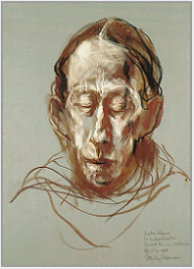
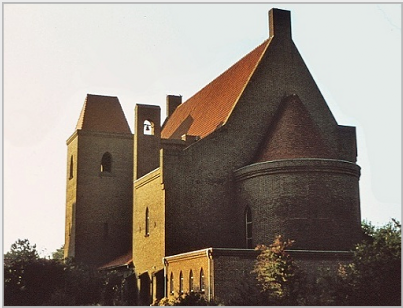
The Keeper of Drawings Dr. Janno van Tatenhove, expressing gratitude to Davis when he brought the work to Leiden, said Roseman's drawings are the first by an American artist acquired for the Leiden Print Room.
The black Benedictine hood forms a dramatic contrast to the monk's ivory complexion and the whiteness of his beard. The artist's painterly modeling of the facial features with shading rendered in bistre chalk brings a warm quality to the intimate portrait of the monk, with eyes closed, as he meditates and prays.
In a thoughtful letter to the artist, Sister Maura writes about her experience of being drawn by Roseman:
The Print Room of the Institute of Art History at the University of Leiden, Prentenkabinet-Kunsthistorisch Instituut der Rijksuniversiteit, conserves the present work Sister Maura in Prayer.
This masterly rendered portrait of Sister Maura exemplifies again Roseman's skillful handling of the chalk medium. Here bistre and white chalks predominate giving sculptural form to the nun's face, warm shading, and luminous highlights. Touches of black chalk add depth to the shadows. Fine lines of black chalk delineate her hair pulled back in a chignon.
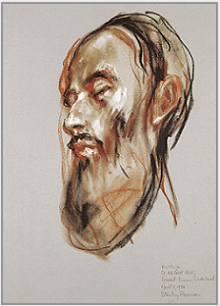
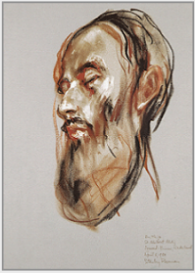
© Stanley Roseman
© Stanley Roseman
© Stanley Roseman
© Stanley Roseman
© Stanley Roseman
© Photo by Ronald Davis
© Photo by Ronald Davis
The Eighty Year's War (1568-1648) ravaged and divided the Low Countries in revolt against Spanish domination and from internal religious conflict. In the devastating warfare, the Abbey was destroyed.
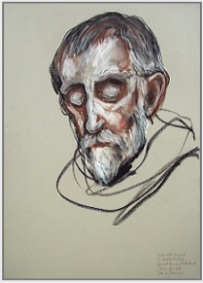
© Stanley Roseman
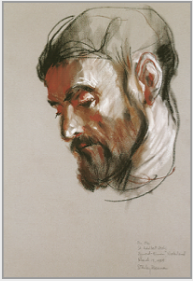
© Stanley Roseman
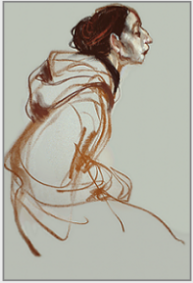
© Stanley Roseman

6. Travels to Sweden and Denmark
3. Historic Regions of Monasticism
in Bavaria and Swabia
in Bavaria and Swabia
Monastic Journey Continued
On the bottom of this page are links to the other pages.
2. Returning to the Netherlands
7. Convents in Piedmont
and Tuscany
and Tuscany
1. A Painting Studio
at the Abbey of La Trappe
at the Abbey of La Trappe
8. Monasteries in Old Castile
4. Returning to England
5. Sojourns in Belgium
Monastic Journey Continued
Page 2 - Returning to the Netherlands
Roseman drew the Abbot in profile, his head inclined, his eyes lowered. Chalks of earth pigments imbue the drawing with a warm tonality. Accents of black chalk delineate the fringe of hair complemented by strong, white highlights on the monk's face and cranium. The artist's drawing of the Abbot of Sion is a deeply felt portrait of a man dedicated to the contemplative life.
